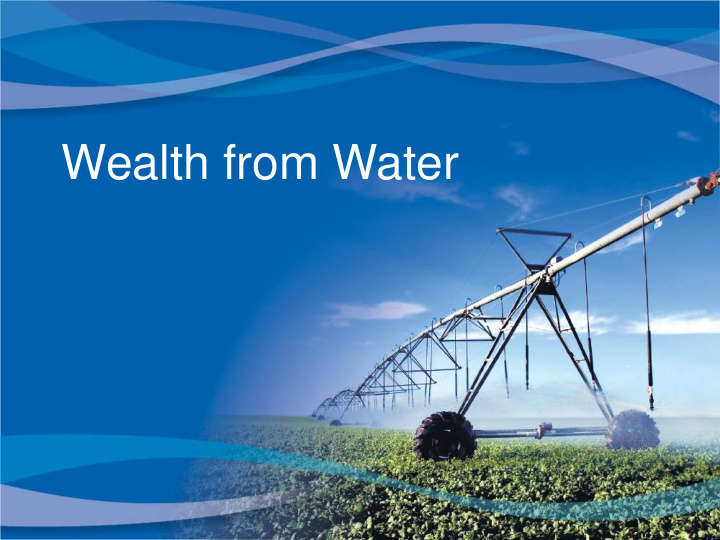



Wealth from Water
Agriculture in Tasmania • $1.683b farm gate 2009/10 • 6% GSP farm gate • c$5.38b FDE (x3.2) • c18% GSP FDE (c7%) • c17,500 people directly employed • 7% state employment (3%) • c16% state employment FDE
Value of Agriculture ($m) 1,800 1,600 1,400 1,200 Agriculture 1,000 Aqua & Fishing 800 Total 600 400 200 0 2003/2004 2004/2005 2005/2006 2006/2007 2007/2008 2008/2009
Our competitive advantages • 0.9% of Australia’s land mass; 14% of the nation’s fresh water; • highest ratio of arable land to population in Australia; • most usable sunshine; • some of the world’s most skilled farmers and researchers.
Why irrigation on farm Diversify Stabilise Drought Income Proof
Economic Social Environmental
Annandale Gross Farm Turnover 1999 to 2010 $2,000,000 5 $1,800,000 $1,600,000 4 Increasing Irrigation capacity $1,400,000 $1,200,000 3 Gross Farm Drought Turnover $1,000,000 $800,000 2 Pre $600,000 Number Of Irrigation Employees $400,000 1 $200,000 $- 0 1999 2000 2001 2002 2003 2004 2005 2006 2007 2008 2009 2010
What is Wealth from Water? • Enterprise Suitability Mapping: soils, climate and crop “rules” • Market and Business Opportunity: tools and information • Extension: irrigation technology, practice and transfer
Facilitation, information exchange & collaboration • Basis in Tasmania’s Economic Development Plan • Aims to assist farmers and potential investors to develop their irrigation businesses and help make the transition to growing the high-value crops best suited to their area • The pilot is pioneering new ways for providing soil, climate and enterprise suitability information, as well as market and business planning support • Help accelerate the change: good information on potential opportunities
Soil Attributes Digital Soil Mapping: DSM provides greater detail vs a traditional soil order map Meander East Irrigation District
Climate Surfaces – Modelling Local Climate Risks
T ools: Enterprise Suitability Mapping Enterprise Suitability = Soil Attributes (Digital Soil Mapping) + OLIVES * Climate Risk + Rules: • Geology (1:25,000 to Crop Suitability 1:250,000), selecting Jurassic Rules Dolerite & Triassic Sandstones • Slopes 5 to 15 % • Elevations below 450m • Private Agricultural Land * Theoretical example only • Northerly Aspects
Olive Suitability – a guide for further on- farm investigations Rules: • ‘Nil risk’ of waterlogging (olives cannot tolerate saturated soils) • Non acidic • ‘Moderate or less’ salinity rating • Slopes greater than 8% to ensure lower risk of waterlogging • Northerly slope aspects for optimum growing conditions • 1:50,000 scale maps * Theoretical example only
T wo case-studies: 1) Meander Valley Irrigation Area ~45,000ha 2) part Midlands Irrigation Scheme ~25,000ha
Recommend
More recommend